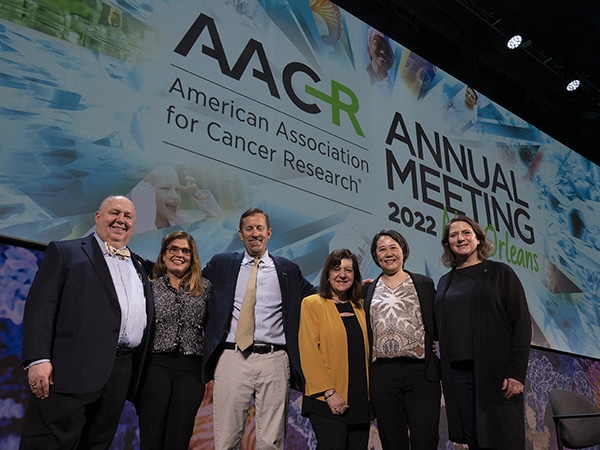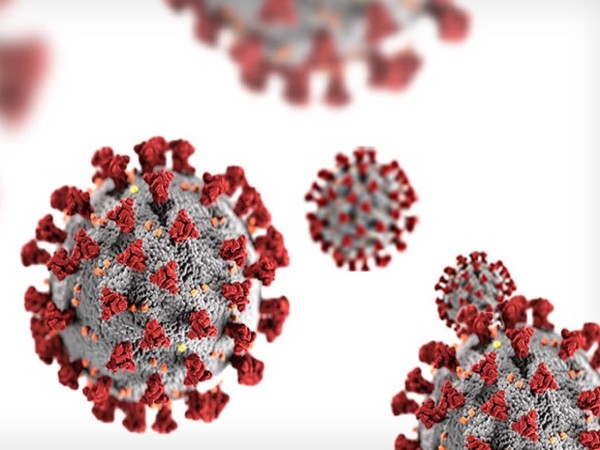Annual Meeting 2022: Highlights and Vision for the Future
As the first AACR Annual Meeting held in person after the pandemic was coming to a close, the last plenary session provided a summary of some of the most exciting research presented during the five-day conference that covered the full spectrum of cancer science.
Annual Meeting Program Committee Chair Marcia R. Cruz-Correa, MD, PhD, who opened the session, shared her feeling of gratitude for the knowledge and information that was shared among the meeting participants—more than 19,000 registered, with about 75 percent attending in person.
This year’s program incorporated five plenary sessions, including one on precancer discovery science and one on tumor evolution. The meeting had more than 1,000 presenters from around the world and more than 5,000 posters.
For this closing session, three esteemed scientists were tasked with presenting the meeting’s highlights in a few main areas.
Highlights From Basic and Translational Research
In his summary, Danny R. Welch, PhD, professor at University of Kansas Cancer Center, drew the audience’s attention to the main basic and translational research themes that recurred during the sessions:
Microbiome. The microbiome was among the most represented themes and is adding a new dimension to cancer prevention and treatment, Welch said. Researchers are elucidating how the microbiome directly influences the behavior of tumor cells, alters the immune responses, and influences response to therapy and metastatic disease. The increasing knowledge on the tumor microbiome is leading to new approaches to treatment, such as microbial transplants, that are being assessed in experimental models as well as early clinical studies.
Tumor microenvironment. Welch said that the new findings through spatial and 3-D genomic studies are highly enlightening and further illustrate the complexity of cancer. As a result of understanding the tumor microenvironment, new treatments are being developed, most spectacularly in the immunotherapy arena, he added.
Of particular interest were the topics related to aging and cellular stress, and how they affect tumor development and progression. A number of presentations and posters focused on the emerging topic of precancer tissue analysis, which, in Welch’s view, is opening a new area of precision prevention.
Metastasis. “If we want to tackle patient outcomes, we have to focus on metastasis, the major cause of morbidity and mortality,” Welch said. “It has now been recognized that metastasis is a genetically distinct phenotype, which is critical to understanding how we can use it as a target.”
Other highlights included clonality and markers of metastasis distinct from primary tumor markers. “We may be at the cusp of understanding the molecular basis for the seed and soil hypothesis that was first proposed almost 140 years ago,” Welch said.
Metabolism. Researchers are now looking at how the tumor cell metabolism and tumor microenvironment metabolism cross-communicate, Welch said. There is increasing awareness that mitochondria contribute to tumor behavior and outcomes in ways that were previously underestimated. For example, his lab showed that altering the mitochondrial genetic polymorphisms impacted metastatic potential, immune infiltration into the metastasis, and regulation of the microbiome, through non-metabolic mechanisms.
Non-coding RNA. An increasing number of non-coding RNA types are being studied. “I was impressed by the number of new classes of RNA identified,” Welch said, noting how new ribosomal and t-RNA fragments are emerging as new biomarkers and therapeutic options.
Targeted protein degraders. Welch discussed the importance of the PROTAC technology and its high specificity, which is opening new classes of therapeutics, particularly for pediatric cancers with chromosomal translocations and chimeric proteins, providing much-needed alternatives to repurposing drugs developed for adult cancers.
Artificial intelligence. The integration of artificial intelligence and machine learning is crucial to interpret and deconvolute the multidimensional data being produced through omics studies, Welch said, noting that these disciplines have been front and center throughout the meeting.
In conclusion, Welch said that cancer researchers are determined to tackle critical problems in a spirit of teamwork with colleagues from other fields, to create a mutually shared vision of making inroads to these challenges to develop better medicines.

Highlights From Disparities Research
“Cancer health disparities occur at every step along the cancer continuum, from prevention through interception and early detection, all the way to survivorship and prevention of recurrence,” said Jennifer A. Doherty, PhD, chief of the Division of Cancer Population Science at the University of Utah and co-leader of the Cancer Control and Population Sciences Program at Huntsman Cancer Institute. “It was a priority of the program planning committee to ensure that cancer disparities were highlighted throughout the meeting.”
As she remarked, compelling data was presented demonstrating that where a person lives profoundly influences their health and access to care. The terms ZNA and zinome were used, reinforcing the importance of the ZIP code.
Studies presented during the meeting focused on inequities in geospatial measures, the impact of neighborhood redlining on breast cancer mortality, the biologic manifestations of structural racism, and the link between discrimination and health outcomes.
Additional presentations called attention to the importance of understanding genetic ancestry in diverse and heterogeneous populations, showed how social and environmental stressors may contribute to elevated cervical cancer rates in certain geographic areas, and suggested that the approaches used to address disparities must be tailored to the specific at-risk and vulnerable populations.
Another study Doherty highlighted represented an example of integrating omics data with structural and social determinants of health to address persistent and pervasive inequities.
Doherty emphasized the importance of a transdisciplinary approach to cancer disparities, which was reflected during this year’s Annual Meeting in a wider focus on multiple factors that generate disparities in cancer incidence and mortality, beyond biologic/genetic aspects and lifestyle.
“As we look towards the future, greater diversity in study populations will translate into better science and reducing health disparities,” Doherty said.
The All of Us research program and the PE-CGS program, discussed in multiple presentations, are examples that go in this direction.
Highlights From Prevention Research
One of the themes related to prevention was obesity, which continues to rise and is associated with 16 cancer types, Doherty said. Studies showed the crosstalk between adipose and tumor tissues, how obesity contributes to systemic inflammation, and the consequences for metastatic disease.
Presenters also discussed new considerations about tobacco use, particularly novel nicotine-containing products. These products may offer harm reduction alternatives for adult addicted smokers, but their appeal to youth should be minimized as it is still not known if and how long-term use contributes to cancer risk.
Highlights From Interception Research
Some interventions to reduce cancer incidence in at-risk individuals, such as breast and ovary removal in women who carry BRCA1/2 mutations, significantly affect quality of life, Doherty said, therefore more research is needed to identify new approaches to cancer risk reduction.
Some of the studies presented in this area highlighted the importance of biologically informed disease interception, such as the use of DNA methylation profiles and circulating mutant DNA as early detection approaches.
The development of cancer vaccines is a particularly exciting frontier for cancer interception, said Doherty, noting that several immuno-interception trials are currently recruiting participants with genomic predisposition to cancer.
Precancer atlases are critical resources for cancer interception because they spatially and temporally map the events that occur during the evolution of a preneoplastic lesion to invasive cancer. One session discussed how the atlas can help address three unmet needs: identifying precancer lesions, predicting which lesions will progress, and finding targets for successful development of interventions to apply before disease onset.
Highlights From Early-detection Research
Early detection is now possible for some cancer types, but access to screening is inconsistent, Doherty said. Several sessions highlighted how this can be improved through community engagement and partnership.
Presentations illustrated the development of new screening modalities, such as a prospective interventional study in 10,000 women without cancer, which evaluated the feasibility and safety of a novel liquid biopsy-based multicancer early detection test. The results of this study showed that blood tests doubled the number of cancers detected by standard-of-care screening alone and that, importantly, 31 percent of cancers detected with liquid biopsies were in organs for which no standard-of-care screening is available.
Concluding her presentation, Doherty illustrated some key priorities in moving the field forward, including designing and interpreting research on cancer to reflect real-world experience; improving how we collect data to include the social environment, measures of discrimination, and behavioral factors; gathering data on the genome of diverse populations to understand the contributions of race, ethnicity, and ancestry to cancer disparities; and validating in diverse populations the exciting advances in cancer vaccines and liquid biopsies, implementing them in the context of community engagement and access. “It will be very exciting to see what next year’s program brings in these areas,” she said.
Highlights From Clinical Research
Lillian Siu, MD, senior medical oncologist at Princess Margaret Cancer Centre and professor at the University of Toronto, Canada, focused her summary on four main topics:
Biomarker-driven precision cancer medicine: DNA damage response (DDR)-targeting drugs and antibody-drug conjugates (ADCs) as examples
Data from several early-phase PARP inhibitor trials were presented during the meeting, with overall response rates (ORRs) between 20 and 30 percent, Siu said. Other presentations focused on DDR targets beyond PARP, many of which are novel and in preclinical development.
As Siu noted, the ADC arena is expanding. Studies presented at the meeting focused on improving the therapeutic index of existing ADCs and developing new ones against novel targets.
Summarizing the future directions for the field of precision cancer medicine, Siu underscored the importance of selecting optimal recommended doses in early-phase trials and the impact of FDA’s new Project Optimus, which provides new guidance for pharmaceutical companies to test a wider range of doses early in development and transition away from using maximum tolerated dose-based approaches.
Optimal sequencing of immuno-oncology (IO) drugs with standard therapy
Neoadjuvant immunotherapy is an attractive emerging strategy, Siu said, highlighting as an example the Checkmate 816 trial, which had practice-changing results that led to the approval of nivolumab (Opdivo) in combination with chemotherapy for resectable non-small cell lung cancer (NSCLC).
Siu said that the neoadjuvant IO approach has a strong biological rationale and is being evaluated in many tumor types, including NSCLC, melanoma, and head and neck cancer. It also allows investigators to leverage the possibility of obtaining pretreatment biopsies and surgical samples to determine biomarkers of response and resistance.
IO combination strategies and new targets beyond PD-1/PD-L1
Siu reviewed some of the immunotherapy combination trials presented at the meeting. One study assessed the anti-PD-1 therapy nivolumab in combination with the anti-CTLA4 therapy ipilimumab (Yervoy) in melanoma refractory to anti-PD-1/L1 therapy. Another study reported on a new PD-1-CTLA4 bispecific antibody, with unique properties different from the combination of the two individual drugs. Siu highlighted the importance of identifying better strategies to determine early in the clinical process whether an IO combination is promising and worth moving forward. Other IO agents beyond PD-1/PD-L1 are also being evaluated as monotherapy or in combination, in phase I and II trials.
Next-generation adoptive cell therapies
Siu highlighted studies with promising results on novel adoptive cell therapies for solid tumors, including a GD2-targeted CAR T-cell therapy for diffuse midline glioma and a CLDN6-targeted CAR T-cell therapy tested in combination with an mRNA vaccine that showed activity in testicular and ovarian cancer.
Siu also highlighted a study of cord blood-derived NK cells complexed with a bispecific antibody that showed a nearly 90 percent ORR in refractory CD30+ lymphomas.
“The future of drug development is very bright,” Siu said, cautioning, however, that many challenges and tasks remain to be fulfilled, including overcoming drug resistance and developing treatments for rare malignancies and challenging diseases such as brain metastasis.
Wrapping up the session, Cruz-Correa thanked the program committee for their vision and guidance in planning the scientific program and the AACR staff for working hard behind the scenes to provide the best experience for attendees. She also acknowledged the hospitality of New Orleans, with its many flavors and great diversity. “See you next year in sunny Orlando,” she concluded.



